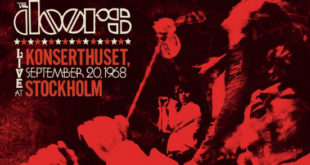After a false start back in May, plans have been confirmed for a biopic of Joy Division singer Ian Curtis, who committed suicide at 23 in 1980:
- The Manchester-based production is called Touching From A Distance, after a book by Curtis’s widow Deborah which forms the basis for the film.
Music mogul Tony Wilson, who headed [Factory] the record company Joy Division were signed to, will be co-executive producer.
….Mr Wilson, who has remained friends with Curtis’s widow and daughter Natalie, who he says asked for his involvement to make the film “official”.
“People have different ideas as to why Ian committed suicide, so maybe the film will reflect those different views,” he told the BBC News website.
….”This is much more than the music – they want to do the real story of Ian,” he said.
The film is to be directed by Dutch-born Anton Corbijn, who has made music movies for Depeche Mode and U2.
It will be produced by a US production company, while the widow of Ian Curtis will also be an executive producer. [BBC]
Joy Division was formed in the fall of 1976 in response to the first Sex Pistols appearance in Manchester. Guitarist Bernard Dicken (later Albrecht, then Sumner) met bassist Peter Hook at the show and formed the Stiff Kittens with Ian Curtis on vocals.
Soon they were called Warsaw and made their live debut opening for the Buzzcocks the following May. After adding drummer Stephen Morris, they became Joy Division (the name of prostitution units in Nazi concentration camps taken from the novel The House of Dolls).
A planned first album was shelved when a studio technician added synthesizers to several tracks (later released as Warsaw). The band liked the sound house producer Martin Hannett got on the Factory Records sampler, so, spurning overtures from major labels, they went with Factory for their first album, Unknown Pleasures.
Factory-owner Tony Wilson zeroed out his trust fund to press 10,000 copies of the record, which was received ecstatically by the press, as was the follow-up, Closer. The epileptic, brooding Curtis hung himself in 1980 at 23, followed by the release of the double album Still in 1981. Joy Division’s huge sphere of influence runs the gamut of modern rock: from the Cure, Psychedelic Furs and newer bands like Interpol, to Nine Inch Nails and Moby.
Great art grows in stature over time, and 25 years after the band’s demise, Joy Division has joined Curtis’ heroes the Doors, along with Velvet Underground, the Stooges and David Bowie atop the moody wing of the rock pantheon.
Hannett helped transform Joy Division from the screech and thrash of their early days to the mapping of dark emotional landscapes that characterized their greatest work. The white water rush and straining of Curtis’ Bowie-esque upper register slowed and broadened into a majestic doomed baritone of stunning dark beauty.
The Joy Division sound employed Hook’s melodic lead bass; Sumner’s sweeping, twisting, ringing guitar; Morris’ touchy, mechanistic drums; Hannett’s synthesizer shadings; and Curtis traversing time and space seeking a hole in the fabric that would lead to peace – a peace he may or may not have found in death.
Hannett took particular interest in the drum sounds: obsessively requiring Morris to dis-and-reassemble his drum kit on the third day of the Unknown Pleasures sessions, making innovative use of echo and delay to create depth and resonance, and helping to create the double snare rhythms that would propel a thousand modern rock dance tunes.
Wilson knew Hannett had a gift, he would “strip these sounds to their perfect, naked form, and then … start creating imaginary rooms for each sound … He could see sound, shape it, rebuild it.”
This he did on the greatest Joy Division songs: the stately “Day of the Lords” with the ominous refrain, “Where will it end?”; the eerie familiarity of “New Dawn Fades” (covered reverentially by Moby on the Heat soundtrack); the robotic inexorability of “She’s Lost Control” – all from Unknown Pleasures.
Closer contributed to the mystique, driven by the lonely, synth-based “Isolation,” with Curtis’ vocals appropriately remote and reverberant.
Still contains, remarkably, even better music: “Transmission,” with its joyless exhortation to “dance, dance, dance, dance, dance to the radio,” reminds us that humans can be as thoughtlessly deterministic as radio waves. “Dead Souls” (NIN’s cover on The Crow soundtrack makes the link between Joy Division and industrial music explicit) makes expert use of dynamics and is Curtis’ finest moment as he rails against the voices from beyond the grave that beckon to him.
“Love Will Tear Us Apart” is one of the greatest singles of all time: a bright, percussive guitar strum gives way to a hypnotic synth line, and then Curtis is almost cheerful as he confides that even love is an agent of isolation.
After Curtis died, the remaining band members (plus Gillian Gilbert on guitar and keyboards) transformed into New Order and a more overtly electronic sound, but that’s another story.
Some excellent Joy Division pics are here.
 Blogcritics The critical lens on today's culture & entertainment
Blogcritics The critical lens on today's culture & entertainment



